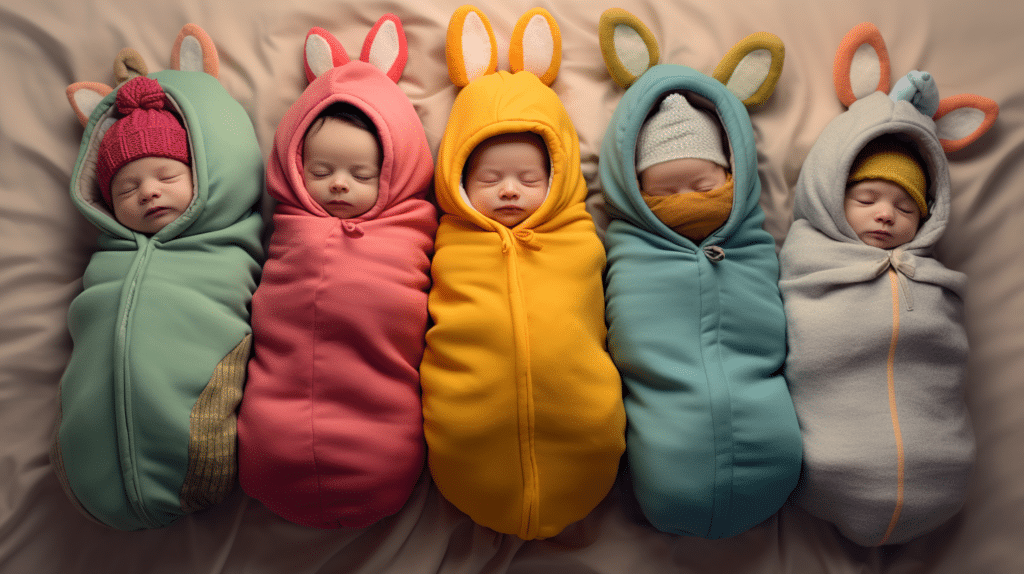Last Updated on August 4, 2023
Ensuring a safe and comfortable sleeping environment for infants is of paramount importance to caregivers, as it contributes significantly to the overall well-being and development of the child. One innovative solution that has gained popularity in recent years is the baby sleeping bag, which offers numerous advantages over traditional bedding options such as blankets and sheets. This article aims to provide an informative guide on baby sleeping bags, discussing their benefits, tog ratings and temperature regulations, suitable sizes and styles for different age groups, as well as safe sleep practices to adhere to when using these products.
In order to make informed choices regarding infant sleepwear, it is crucial for caregivers to have a thorough understanding of various factors that can impact the safety and comfort of their child. These include selecting appropriate tog ratings based on room temperature conditions, choosing suitable sizes and styles that ensure proper fit while allowing for growth spurts, adhering to recommended guidelines by health professionals on safe sleep practices while using baby sleeping bags, and understanding relevant regulations surrounding these products. The following sections will delve into each of these aspects in greater detail in order to equip readers with valuable knowledge pertaining to this essential aspect of early childhood care.
Key Takeaways
- Tog ratings are important in choosing the right sleeping bag for the baby based on the room temperature.
- Choosing the appropriate size and tog rating of the sleeping bag is crucial for the baby’s safety and comfort.
- Safe sleep practices should be observed to mitigate the risks associated with SIDS and other potential hazards during sleep.
- Different types of sleeping bags cater to specific needs and environmental conditions, impacting comfort, safety, and sleep quality.
Benefits of Baby Sleeping Bags
Undeniably, baby sleeping bags offer numerous advantages, such as promoting safety, providing comfort, and ensuring consistent temperature regulation for infants during slumber. A baby sleeping bag, also known as a wearable blanket, is designed to provide a constant temperature by surrounding the infant with an insulated layer of material. This design ensures that the baby maintains a comfortable temperature throughout the night without overheating or becoming too cold. The neck hole and armholes in these bags are specifically designed to fit snugly around the infant’s body, preventing them from slipping inside the bag during sleep.
Research has demonstrated that maintaining a safe temperature is essential for reducing the risk of Sudden Infant Death Syndrome (SIDS). One key benefit of using baby sleeping bags is that they eliminate the need for additional blankets or coverings, which can pose suffocation hazards. Furthermore, these wearable blankets prevent babies from kicking off layers during their sleep, thus ensuring that they remain covered and at a consistently safe temperature throughout their rest period.
The use of baby sleeping bags instead of traditional loose blankets provides multiple benefits for parents seeking to create an optimal sleep environment for their infants. With these products on hand, caregivers can be confident in providing both safety and comfort for their little ones while also eliminating concerns related to inconsistent temperatures or potential suffocation risks associated with loose bedding materials. By selecting an appropriately sized and tog-rated sleeping bag for their child’s age and room conditions, parents can ensure a safer and more comfortable night’s sleep for all involved.
Tog Rating and Temperature
Evidently, understanding the concept of tog rating and its correlation to temperature is crucial in ensuring a comfortable and safe environment for an infant during sleep. Tog rating is a measure of thermal resistance, indicating how well a fabric insulates heat. In the context of baby sleeping bags, this measure helps caregivers select the appropriate sleeping bag depending on the ambient temperature in their child’s room. A higher tog rating corresponds to greater insulation properties, making it suitable for colder temperatures, while a lower tog rating would be more appropriate for warmer weather.
When choosing a baby sleeping bag with the right tog rating, consider these factors:
- Warmer weather: For hot weather or rooms with temperatures above 24°C (75°F), opt for lightweight cotton fabrics with a low tog rating such as 0.5 or 1.
- Moderate climate: For average room temperatures between 18°C (64°F) and 23°C (73°F), choose a medium tog-rated sleeping bag around 2.
- Colder nights: If room temperatures fall below 18°C (64°F), select higher tog ratings like 3.5 to keep your baby warm throughout the night.
It is essential to maintain consistent temperature conditions when using baby sleeping bags because fluctuations might compromise an infant’s comfort and safety during rest periods. To achieve this consistency, caregivers should monitor room temperatures regularly and adjust bedding or clothing layers accordingly while considering their child’s activity level before sleep time. By doing so, they can ensure that their little ones experience perfect temperature regulation within their baby sleeping bags – facilitating sound sleep cycles conducive to healthy growth and development.
Sleeping Bag Sizes and Styles
Selecting the appropriate size and style of an infant sleep sack plays a significant role in providing optimal comfort and safety during slumber. Baby sleeping bags are designed to replace traditional blankets, which can pose a risk of suffocation or overheating. By choosing the correct sizes and styles of sleeping bags, parents can ensure their child is secure and comfortable throughout the night. It is essential to select a size that corresponds with the baby’s weight and age, as this will prevent the child from slipping down into the bag during sleep time. Furthermore, it is crucial to consider how roomy or snug the design should be for your baby’s specific needs.
There are various styles of baby sleeping bags available in today’s market, catering to different weather conditions and personal preferences. For instance, during warm summer months, a lighter-weight sleep sack made from breathable materials such as cotton or muslin may be more suitable than heavier fabrics, which could cause overheating. Conversely, for winter months or colder climates, thicker materials like fleece or quilted fabric may provide extra warmth without compromising on safety features such as armholes and neck openings that prevent infants from becoming too enclosed within their sleep environment.
In selecting suitable baby sleeping bag sizes and styles for one’s child, it is important to keep in mind factors such as climate variations between seasons, growth patterns over time, and individual preferences based on personal observations of your baby’s sleeping habits. By investing in adaptable options that cater to these variables while maintaining crucial safety elements like snug-fitting neck openings or adjustable armholes, parents contribute significantly towards reducing risks associated with sudden infant death syndrome (SIDS). Thus, making informed choices about appropriate sizing and styling ensures both comfort and security during infants’ most vulnerable periods at night time while promoting healthy development into childhood years.
Safe Sleep Practices
Implementing safe sleep practices is crucial in reducing the risk of sudden infant death syndrome (SIDS) and ensuring a secure, comfortable environment for infants during their slumber. Adhering to a baby sleeping bag guide can be beneficial in selecting the appropriate baby sleep bags that promote safety and comfort while minimizing the risk of suffocation. It is essential to consider specific factors such as material, size, and tog rating when choosing a sleeping bag for an infant.
- Material: Opt for materials that are gentle on an infant’s delicate skin, such as natural fibres like cotton or bamboo. These fabrics allow for breathability and help regulate body temperature, making them ideal choices for summer sleeping bags.
- Size: Ensure proper fit by selecting a sleeping bag suitable for an infant’s age, weight, and length to prevent any potential hazards associated with ill-fitting sizes. An appropriately sized sleeping bag will also support healthy hip development.
- Tog Rating: The thermal resistance or warmth provided by a sleeping bag is measured using the tog rating system; higher tog ratings indicate increased insulation levels. Choosing the correct tog rating based on room temperature helps maintain a safe environment without requiring additional covers.
When implementing safe sleep practices, it is essential to seek expert tips and recommendations from reputable sources such as healthcare providers or professional organizations dedicated to promoting child safety and well-being. Moreover, periodic reassessment of these practices will ensure continued suitability as infants grow and develop at varying rates throughout their early lives. By adhering to established guidelines regarding baby sleep bags within this context, caregivers can foster a secure environment conducive to restorative slumber while mitigating risks associated with SIDS and other potential hazards during infancy.
Types of Sleeping Bags
Exploring the various types of sleeping bags available for infants can significantly impact their comfort, safety, and sleep quality, as each design caters to specific needs and environmental conditions. A baby sleeping bag guide can help parents navigate through various options when it comes to choosing the right type for their child. There are generally three main types of sleeping bags for babies: standard, travel, and swaddle or transition bags. Standard bags typically have a zip or poppers on the side or bottom and are designed to keep babies warm while allowing them to move freely in a frog-legged sleeping position. Travel bags come with an additional opening that makes it possible to use them with car seats and strollers. Swaddle or transition bags aim to mimic the feeling of being swaddled while still providing enough room for movement.
Each type of sleeping bag is available in different tog ratings (thermal insulation) levels suitable for varying temperatures, ensuring that babies stay comfortable throughout the year. It is crucial to choose an appropriate tog rating based on a baby’s age range and the season they will be using it in; this helps maintain optimum body temperature during sleep. For instance, lower tog ratings are ideal for warmer months while higher ones cater well towards colder seasons within British climate zones.
Selecting an appropriate size is also vital when considering safe sleeping practices with infants’ sleep sacks. Since these items are usually designed based on age ranges, purchasing one that fits snugly around your baby’s shoulders prevents any risk of slipping down over their head during sleep. Further considerations include fabric materials like cotton blends which promote breathability, while organic variants offer hypoallergenic properties beneficial for sensitive skin types. In essence, understanding the different types of sleeping bags ensures optimal comfort and safety throughout various developmental stages in infancy while catering effectively towards diverse environmental conditions experienced by families worldwide, promoting better sleep quality for both the infants and their parents, and ultimately contributing to the overall well-being and healthy development of the child.
Frequently Asked Questions
How do I safely transition my baby from a swaddle to a sleeping bag?
In order to safely transition an infant from a swaddle to a sleeping bag, it is crucial to consider the age, developmental stage, and individual preferences of the child. Typically, this transition should commence when the infant exhibits signs of rolling over or starts breaking free from their swaddle, which usually occurs around 3-4 months of age. Introducing the sleeping bag gradually by first allowing the baby to nap in it during the daytime can help familiarize them with this new sleep environment. Moreover, ensuring that the chosen sleeping bag adheres to safety guidelines, such as appropriate sizing and materials that prevent overheating, is essential for a secure and comfortable transition. Parents and caregivers should closely monitor their infant’s response throughout this process in order to make necessary adjustments or seek professional guidance if needed.
Can I use a sleeping bag for my newborn, or is there a minimum age requirement?
It is essential to consider the age and developmental stage of an infant when determining the appropriateness of using a sleeping bag. Generally, sleeping bags are designed for babies aged three months and older, as they have better head control and are less likely to experience sudden infant death syndrome (SIDS) compared to newborns. However, some manufacturers offer sleeping bags explicitly designed for newborns with appropriate neck openings and armholes that reduce the risk of SIDS. It is crucial to adhere to safety guidelines such as ensuring proper fit, maintaining an ideal room temperature, and avoiding any loose bedding or soft objects in the sleep environment when utilizing a sleeping bag for infants at any age.
How do I know if my baby is too warm or too cold while in a sleeping bag?
Determining if an infant is too warm or too cold while utilizing a sleeping bag can be achieved by monitoring for various signs and symptoms. Overheating may present as sweating, damp hair, flushed cheeks, rapid breathing, or heat rash; conversely, if the infant feels cold to touch (particularly their hands and feet), they may require additional warmth. Additionally, assessing the room temperature is essential: maintaining an optimal range between 16-20°C (60-68°F) promotes comfort and safety. Furthermore, selecting a sleeping bag with appropriate tog rating (a measure of thermal resistance) according to seasonal variations assists in regulating the infant’s body temperature effectively. If uncertainty arises regarding the infant’s comfort level, consulting healthcare professionals for guidance is encouraged.
Can a baby sleeping bag help with sleep training and establishing a sleep routine?
A baby sleeping bag can contribute to sleep training and establishing a sleep routine by providing a consistent and comfortable sleeping environment. Research suggests that maintaining a regular bedtime routine, including consistent sleep cues such as using a sleeping bag, can improve infants’ sleep quality and duration (Mindell et al., 2015). The familiar sensation of being in the sleeping bag may signal to the infant that it is time for bed, thus promoting self-soothing and facilitating longer stretches of uninterrupted sleep. Additionally, baby sleeping bags help regulate body temperature throughout the night, ensuring optimal comfort for the infant (Baddock et al., 2010). In summary, incorporating a baby sleeping bag into an infant’s bedtime routine may aid in sleep training and contribute to better overall sleep quality.
What materials and features should I look for in a high-quality baby sleeping bag?
In selecting a high-quality baby sleeping bag, it is crucial to consider materials and features that promote comfort, safety, and appropriate temperature regulation. Materials should be breathable and soft, such as cotton or bamboo-based fabrics, to facilitate adequate air circulation and prevent overheating. A suitable tog rating (thermal insulation) is also essential in ensuring the baby’s optimal comfort throughout the night by catering to different seasons and room temperatures. Additional features may include a two-way zipper for ease of diaper changes, adjustable armholes or neck openings for proper sizing and fit, as well as compliance with relevant safety standards. Furthermore, hypoallergenic materials are advisable for babies with sensitive skin or allergies to minimize irritation during sleep.
Conclusion
In conclusion, baby sleeping bags offer a multitude of benefits for infants and their caregivers. The tog rating system provides an effective method for ensuring temperature regulation while various sizes and styles cater to the needs of growing children. Additionally, these innovative products promote safe sleep practices by minimizing hazards such as loose blankets or overheating.
Thus, investing in a suitable baby sleeping bag is a prudent decision for parents striving to create a secure and comfortable sleep environment. This evidence-based approach contributes significantly to promoting overall infant well-being and development.



